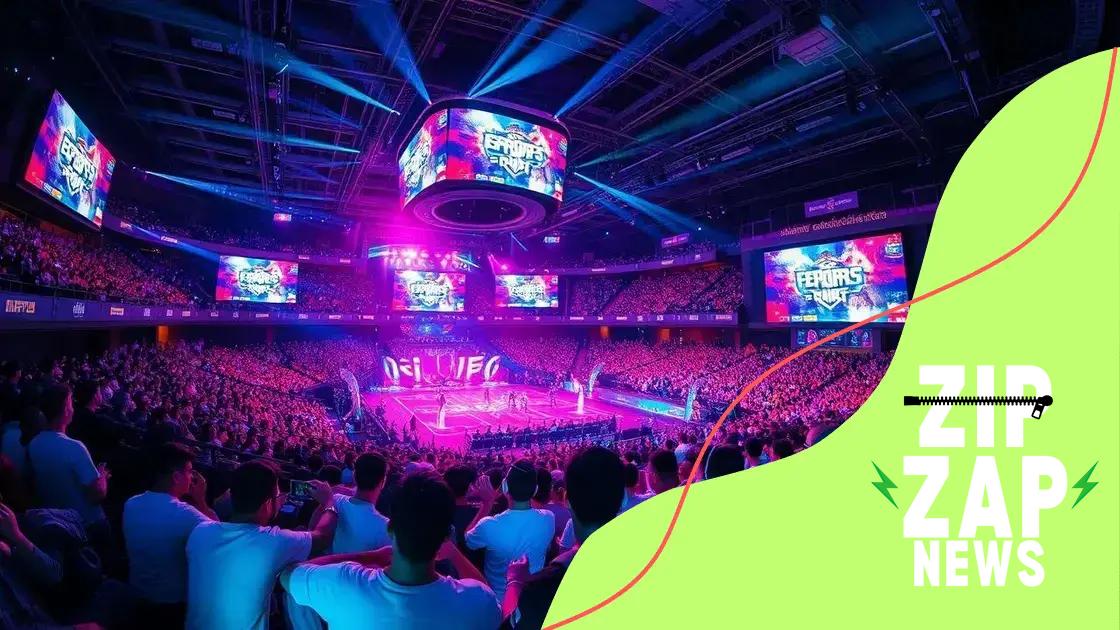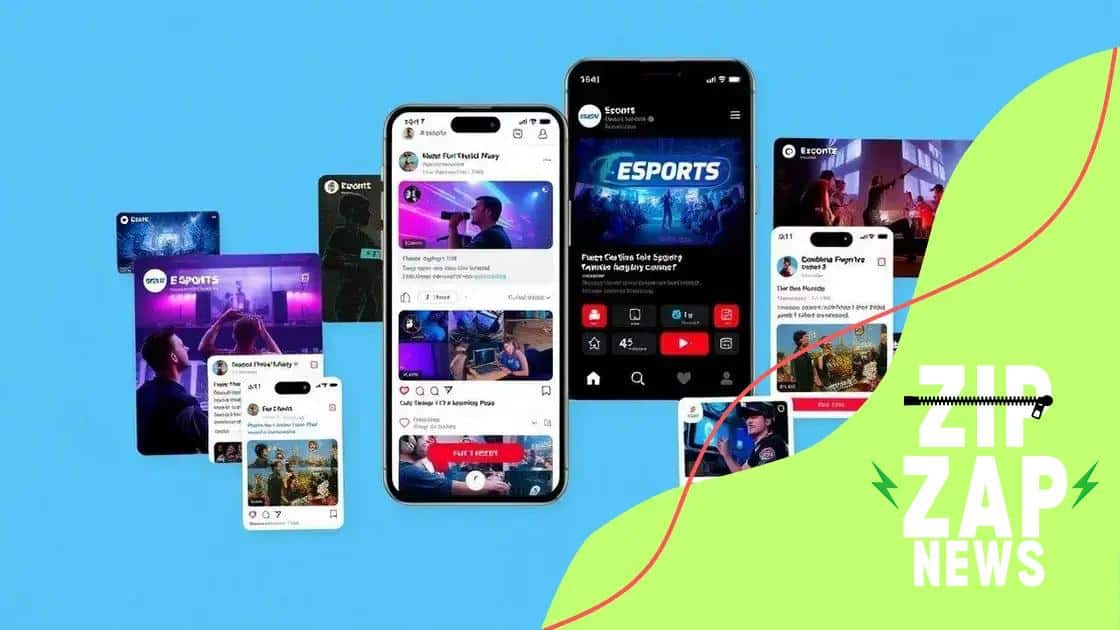How e-sports are influencing mainstream media content

How e-sports are influencing mainstream media content is evident through the integration of technology, increased social media engagement, and the growth of fandom, leading to immersive experiences and professional opportunities in the entertainment industry.
Wondering how e-sports are influencing mainstream media content? This growing phenomenon is merging gaming with traditional networks, creating a new wave of entertainment. Let’s dive into how this shift is happening and what it means for you.
The rise of e-sports in popular culture
The rise of e-sports in popular culture is a fascinating phenomenon that has transformed the way we view gaming and competition. No longer just a niche hobby, e-sports has surged into the mainstream, captivating millions around the globe.
This growth can be seen in various aspects of our lives, from television broadcasts to major sports events. People of all ages are tuning in to watch their favorite teams compete in blockbuster tournaments. This transformation is not only reshaping the gaming community but also bridging gaps with traditional sports.
Popularity among Young Audiences
One of the significant factors behind the growth of e-sports is its widespread appeal to younger audiences. Kids and teenagers are drawn to the excitement and camaraderie found in gaming. With platforms like Twitch and YouTube, they can easily access live streams and recorded games.
- Younger demographics are actively engaging with e-sports.
- Streaming platforms provide instant access to game content.
- E-sports tournaments attract large online audiences.
Additionally, high-profile sponsorships from major companies have propelled e-sports into the spotlight. Many viewers now see it as a legitimate sport, on par with basketball or soccer. Participating in esports events offers not only entertainment but also career opportunities, which further fuels its appeal.
Crossover with Traditional Media
The crossover between e-sports and traditional media has also been remarkable. Major sports networks are broadcasting live e-sports events, allowing broader audiences to engage with the content. This trend highlights the legitimacy of e-sports in the eyes of sports fans.
Schools are even introducing e-sports into their programs, fostering skills such as teamwork and strategic thinking. As a result, the dialogue around e-sports continues to evolve, presenting it as a valuable pastime rather than just an escape.
Overall, the rise of e-sports in popular culture signifies a shift in how we view gaming and competition, promising exciting developments for years to come.
How e-sports events are broadcasted
Understanding how e-sports events are broadcasted is crucial for appreciating their popularity. These events are presented in highly engaging formats that attract millions of viewers worldwide.
Typically, e-sports events are streamed live on platforms like Twitch and YouTube, providing real-time action to fans. This accessibility allows viewers from anywhere to watch their favorite games and teams compete. Every match is crafted to create excitement and maintain viewer interest.
Production Quality
High production quality is essential for capturing audience attention. Professional broadcasting teams use multiple camera angles to showcase action effectively. They include close-ups of player reactions and in-game footage to keep the experience dynamic.
- Advanced graphics show live statistics and player information.
- Commentary enhances the viewing experience by explaining strategies.
- Chat features allow community interaction during matches.
Moreover, these broadcasts often feature analysts who dissect gameplay, similar to traditional sports commentary. This additional layer adds to the thrill, helping viewers to understand intricate strategies and moves.
Engagement Strategies
To further engage audiences, organizers utilize social media to promote events. Viewers can participate in discussions, vote on their favorite teams, or win prizes through interactive polls. These strategies create a sense of community around e-sports events.
Innovative features, like virtual reality broadcasts, are gaining traction, offering immersive experiences that could redefine how we watch sports. As technology improves, the possibilities for the future of e-sports broadcasting are endless. This evolution shows that e-sports is not just a trend; it’s becoming a staple in the entertainment world.
The role of social media in e-sports

The role of social media in e-sports is pivotal in connecting fans, players, and teams. Platforms like Twitter, Instagram, and TikTok allow real-time updates and interactions, creating an engaging community.
Gamers and fans alike use social media to share highlights, strategies, and personal experiences. This constant communication fosters a sense of belonging among players and supporters. As a result, social media acts as a bridge, enhancing the visibility of e-sports events.
Building Fan Communities
One significant impact of social media is the ability to build fan communities that share a love for specific games or teams. These communities often create hashtags and organize discussions around trending topics.
- Fans engage with game developers and influencers.
- Players share their gameplay, advice, and personal stories.
- Communities organize online tournaments and events.
This engagement helps new players learn the ropes while keeping veteran gamers invested in their favorite titles. Such interactions create an inclusive atmosphere where everyone can contribute.
Promotions and Sponsorships
Social media also plays a crucial role in promotions and sponsorships. Teams and players often partner with brands to promote products and services. These partnerships often lead to exclusive deals and promotions that fans can benefit from.
Furthermore, streamers and influencers utilize platforms to showcase products live. This exposure to a targeted audience helps brands reach fans in ways traditional advertisements cannot. As a result, sponsorships in e-sports have skyrocketed, bringing substantial revenue to the industry.
Overall, the role of social media in e-sports is transformative, influencing how communities are formed and how the industry interacts with fans. As technology advances, this connection will likely grow even stronger, solidifying e-sports as a mainstay in digital entertainment.
Comparing e-sports to traditional sports
Comparing e-sports to traditional sports reveals many similarities and differences, showcasing how both worlds engage fans in unique ways. At a glance, both types of sports involve competition, teamwork, and strategy.
In traditional sports, teams train for physical endurance and skill in games like basketball or soccer. In contrast, e-sports teams focus on mental agility and hand-eye coordination. Players spend hours practicing to improve their gameplay, just like athletes on a field.
Fan Engagement
Another aspect to consider is fan engagement. Traditional sports have stadiums filled with cheering fans, while e-sports attract viewers through online platforms. This digital engagement allows fans to witness matches anywhere and connect with the gaming community.
- Fans enjoy live streams with real-time interactions.
- Social media keeps fans updated about their favorite teams.
- Merchandising in both sports helps create loyalty.
Both e-sports and traditional sports utilize branding and sponsorships for revenue. Popular teams secure sponsorship deals to fund their operations and attract new players. However, traditional sports tend to have a longer history of established brands in their corner.
Scalability and Audience
The audience base also differs notably. While traditional sports have solid fan bases built over decades, e-sports are rapidly growing with younger demographics. Games appeal to teenagers and young adults, engaging them through interactive content.
Furthermore, traditional sports often have game durations ranging from minutes to hours, while e-sports can have varying lengths depending on the format. This flexibility caters to the attention spans of modern audiences, making it easier for fans to tune in.
Overall, comparing e-sports to traditional sports highlights both fields’ evolving nature and the competing dynamics that draw fans to each. As both continue to grow, they are reshaping public perceptions of competition and entertainment.
Future trends in e-sports and media
Future trends in e-sports and media are poised for significant growth. As technology evolves, the ways fans engage with e-sports will become more immersive and interactive. This evolution promises to change how we consume gaming content forever.
Recent advancements in virtual reality (VR) and augmented reality (AR) are opening new doors for e-sports. Imagine stepping into a virtual arena where you can watch your favorite teams compete as if you were right there. These technologies allow fans to experience matches in more engaging ways than ever before.
The Rise of Mobile Gaming
Mobile gaming is another critical factor shaping the future. As smartphones continue to improve, games are becoming more sophisticated. This rise allows for larger audiences who can enjoy e-sports matches on the go. Tournaments will likely adapt to include mobile gaming, attracting even more fans.
- More games will be optimized for mobile play.
- Accessibility will lead to increased participation in e-sports.
- Viewers will engage with tournaments directly from their devices.
Additionally, streaming platforms are expected to innovate. Features like interactive voting and the ability to switch perspectives during live matches will enhance the viewer experience. This interactivity allows fans to feel like they’re part of the action, not just passive spectators.
Sponsorship and Monetization
Moreover, sponsorships will evolve, with brands seeking to create authentic connections with audiences. As e-sports gain more mainstream acceptance, companies will invest more heavily in partnerships and advertising within e-sports events. This trend can lead to exciting opportunities for teams and players.
Finally, we can expect a greater focus on professional development within the industry. As e-sports grow, educational institutions may offer programs in game design, management, and even commentary. This shift can enhance the professionalism of the industry, ensuring e-sports continue to thrive.
FAQ – Frequently Asked Questions about E-sports and Media
What are the future trends in e-sports?
Future trends include immersive experiences through VR and AR, increased mobile gaming, and more interactive streaming features.
How will social media impact e-sports?
Social media will continue to connect fans, players, and brands, enhancing engagement and promoting events effectively.
What role do sponsorships play in e-sports?
Sponsorships provide financial support and brand visibility, helping teams and events grow, while brands gain access to targeted audiences.
How is e-sports compared to traditional sports?
Both e-sports and traditional sports share competition, teamwork, and strategy, but they differ in audience engagement, format, and skill requirements.





